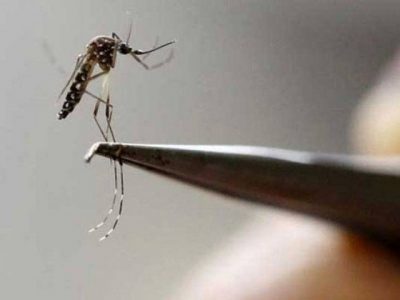- Home
- Editorial
- News
- Practice Guidelines
- Anesthesiology Guidelines
- Cancer Guidelines
- Cardiac Sciences Guidelines
- Critical Care Guidelines
- Dentistry Guidelines
- Dermatology Guidelines
- Diabetes and Endo Guidelines
- Diagnostics Guidelines
- ENT Guidelines
- Featured Practice Guidelines
- Gastroenterology Guidelines
- Geriatrics Guidelines
- Medicine Guidelines
- Nephrology Guidelines
- Neurosciences Guidelines
- Obs and Gynae Guidelines
- Ophthalmology Guidelines
- Orthopaedics Guidelines
- Paediatrics Guidelines
- Psychiatry Guidelines
- Pulmonology Guidelines
- Radiology Guidelines
- Surgery Guidelines
- Urology Guidelines
Brazil scientists develop biosensor for cheap dengue diagnosis

TEPIC, Mexico (Thomson Reuters Foundation) - Brazilian scientists have developed a biosensor that can quickly detect dengue and could help create a cheap tool to diagnose the painful mosquito-borne virus that infects millions each year.
They are looking to produce a testing kit that would cost clinics and hospitals around $30 and take about 15 minutes to analyze blood samples for a key dengue protein, said Cleverton Luiz Pirich, a researcher at the Federal University of Paraná.
A biosensor is an analytical device that converts a biological response into an electrical signal.
“You can do a diagnosis very fast, at a very low cost, and you don’t need to have a lot of knowledge of this equipment,” Pirich said by telephone from Curitiba in southern Brazil.
“The innovation of our work is not specific to dengue - you can use it for other diseases,” he added.
The scientists coated the biosensor with a thin film of bacterial cellulose nanocrystals, which effectively detected a protein known as NS1 from blood samples, according to results published in the journal Biosensors and Bioelectronics.
They now want to explore ways to create cost-effective biosensor components that could be used to analyze multiple blood samples, said Pirich.
The technology could potentially be adapted to detect proteins from viruses such as Zika, which is also transmitted by the Aedes aegypti mosquito, he added.
Endemic in Latin America and Asia, dengue infects hundreds of millions of people each year, and is becoming more prevalent. It is often hard to diagnose as the symptoms, which include fever and severe joint pain, are similar to a number of other diseases.
Simple tools such as testing blood from a finger prick, used to detect malaria, are not available for dengue, and there is no dedicated treatment for the virus which is usually found in urban and semi-urban areas.
Dengue has spread to more than 100 countries from nine in 1960, according to the World Health Organization, with cases rising to 390 million a year from 15,000 in 1960.
Experts say the increased movement of people and goods due to globalization, as well as worsening floods linked to climate change, are likely to speed up the spread of dengue.
The economic impact is potentially huge, with the disease estimated to cost the Americas $2.1 billion annually, while Southeast Asian economies could lose almost $2.4 billion.
(Reporting by Sophie Hares; editing by Megan Rowling. Please credit the Thomson Reuters Foundation, the charitable arm of Thomson Reuters, that covers humanitarian news, climate change, resilience, women's rights, trafficking and property rights.)

Disclaimer: This site is primarily intended for healthcare professionals. Any content/information on this website does not replace the advice of medical and/or health professionals and should not be construed as medical/diagnostic advice/endorsement or prescription. Use of this site is subject to our terms of use, privacy policy, advertisement policy. © 2020 Minerva Medical Treatment Pvt Ltd